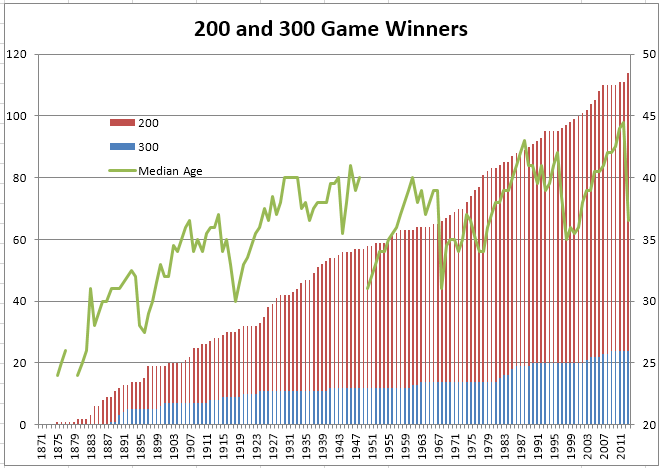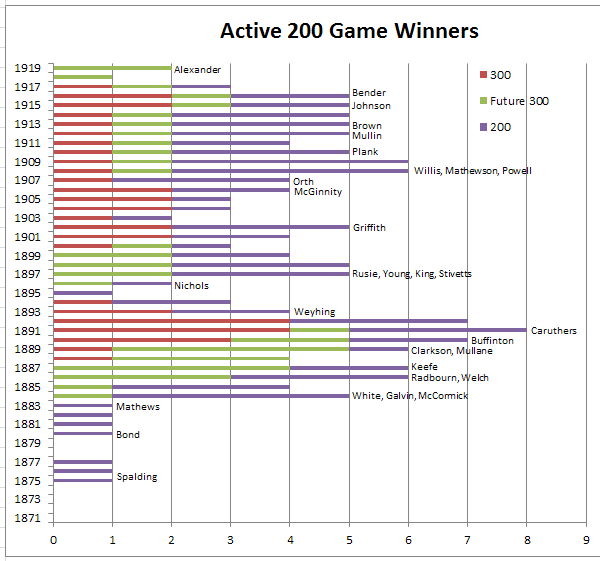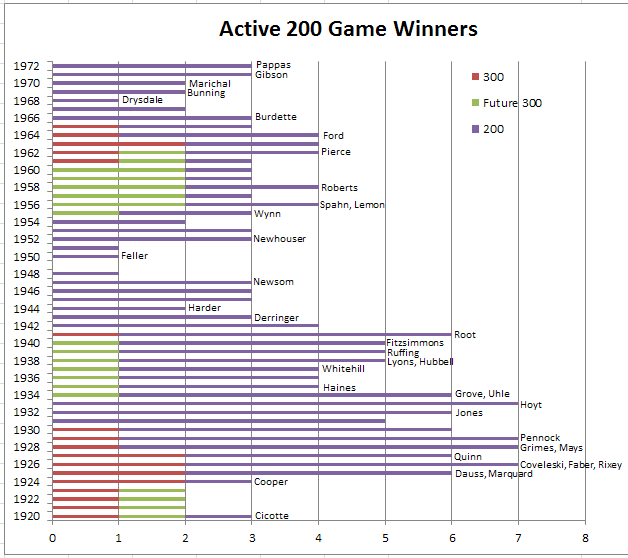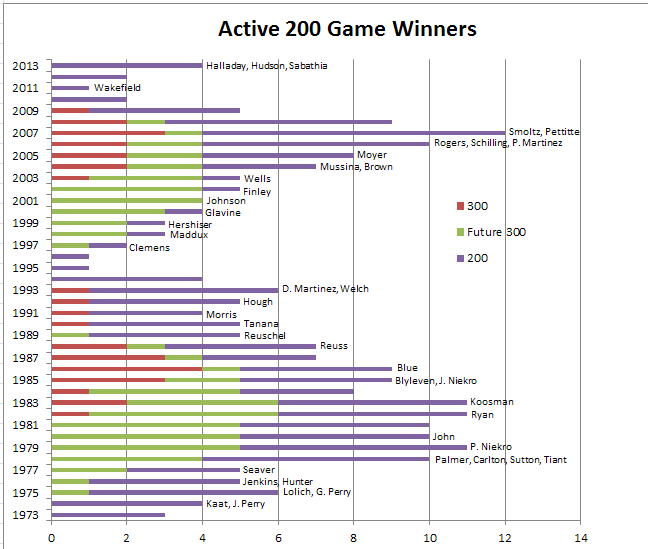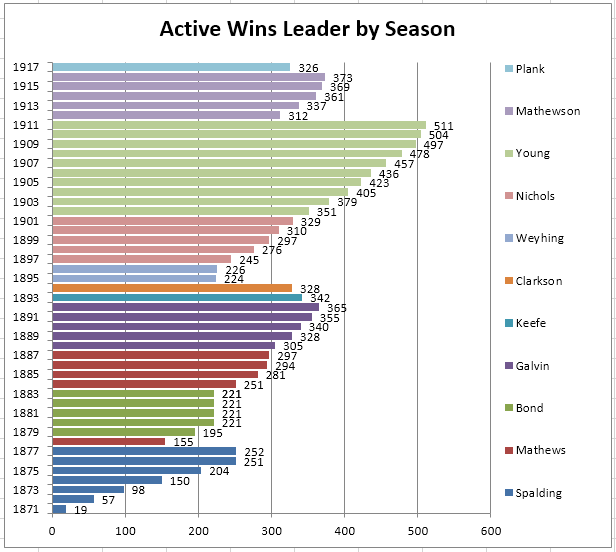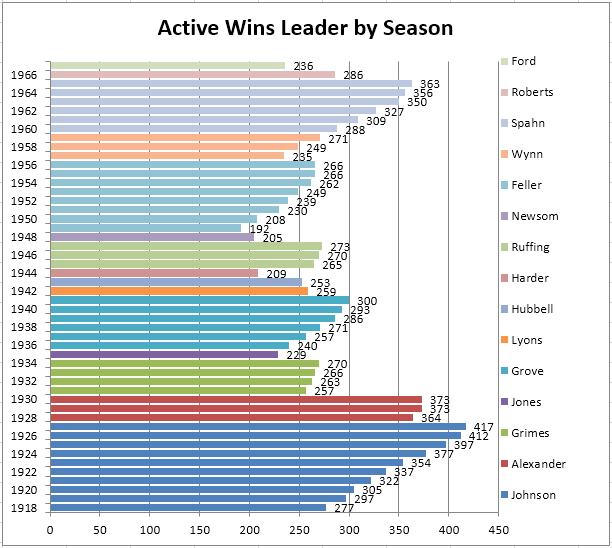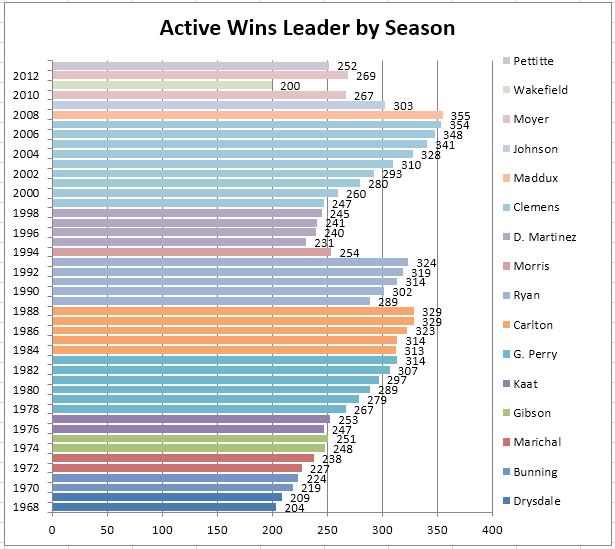After a flurry of 300 game winners in the first decade of this century, attention is focused again on who might be the next pitcher to reach this most celebrated of pitching milestones. As well, there has been as much or more speculation as to whether there will be another 300 game winner, what with the ever-increasing “care” with which pitchers are handled and the decline of the complete game to almost negligible levels.
Lost in the speculation about 300 wins is the fact that to reach that level a pitcher must obviously first pass 200 wins, a not insignificant accomplishment in itself. As there has been the unusual occurrence of 3 pitchers reaching 200 wins this season, it seems an opportune time to look a bit closer at that milestone.
After the jump, more on the 200 win club.
Let’s start with the history of the 200 win club, now with 114 members, Here’s a chart showing, by year, the number of 200 win pitchers, including the subset in the 300 win club.
Despite the increasing numbers of teams in the expansion era, growth in the 200 win club has shown a remarkably constant trend. That said, the rarity of 200 game winners has obviously become more pronounced in the expansion era than previously. Rarer still, of course, are the 300 game winners which, aside from a few periods of rapid growth, increase in number at a very slow rate indeed. Notable among those growth periods are the preceding decade and also the middle 1980s, both clearly visible on close inspection of the chart.
The increased rarity of the 200-game winner is also suggested by the overlaid line (plotted on the right axis) showing the median age of the active 200 game winners. 19th century pitchers normally reached 200 wins in their late twenties and early thirties (and, consequently, were frequently done shortly thereafter). Pud Galvin and Will White had as many as 75 starts in a season, and there have been 160 other seasons of 50+ starts, the last by Jack Chesbro in 1904. With downward trending of workloads, it takes longer for pitchers to reach 200 wins with the result that only older pitchers will reach this milestone today. That fact is graphically illustrated by the 200-game winners of the previous decade with median ages well into their forties, though this was also influenced by the unusual confluence of multiple 300 game winners during this period.
Next, let’s look at how many 200 and 300 game winners were active at any point in time. Following are charts for the entire history of the major leagues, showing the number of 200 game winners active in each season. For the purposes of this analysis, a pitcher must appear in a game to be active in a season (thus, a pitcher may be active, then inactive, then active again owing to injury, war or other circumstances). The totals for each season are broken down into 300 game winners, pitchers who would later reach 300 wins, and those who finished below the 300 level. Beside the bars are the names of 200 win pitchers, in the season in which they reached that milestone.
HOFer Al Spalding was the first pitcher to 200 wins, doing so in only 5 seasons, with win totals of 19, 38, 41, 52, and 54. Spalding had just 5 losses in the last of those seasons in 1875, a .915 winning percentage, the best of any season with 20+ decisions.
In the late 1880s and early 1890s, a majority of the active 200 win pitchers were 300 or future 300 game winners, including the 1888 season with four active 200-game winners who would all reach 300 wins. It would be over 100 years before that happened again with as many as four pitchers. Notable also are the peaks and troughs phenomenon, with sudden dips in the mid-1890s and late 1910s, patterns that recur in later years.
Quite a different looking chart for the next period. Where there was as much red and green as purple in the previous chart, now there are large swaths of purple and little of the other colors, indicative of a paucity of 300 game winners, especially relative to the number of 200 game winners. This is most notable for the 30-year period from 1931 to 1960 with but a single 300-game winner, Lefty Grove, and he only just so, finishing right on the number (as an aside, by today’s rules, Grove would have reached no more than 298 wins, with two of his credited wins coming in starts in which he pitched less than 5 innings of a 9-inning game).
The impact of the lost seasons due to military service is also evident, with at least 4 active 200-game winners every year from 1925 to 1942, but not again until 1956. Included in this period is the entire 1949 season and the first part of the 1950 season, when there were no active pitchers at the 200-win level, an occurrence not seen again until more than 60 years later.
The next period shows the greatest sustained concentration of active 200-win pitchers, running from the late 1970s to the late 1980s. The peak of 6 current or future 300-win pitchers in 1980 and 1981, at least five such pitchers for 8 seasons (1979 to 1986), and at least four for 10 seasons (1978 to 1987) are all without equal before or since. Not coincidentally, most of the pitchers represented in this period made their debuts in the early expansion years in the 1960s, with that sizable increase in teams and pitchers no doubt contributing to the later “bumper crop” of 200 and 300 game winners.
From a peak of eleven 200-win pitchers reached in 1979, 1982 and 1983, that number was halved 10 years later, and than dropped to just a single 200-game winner in 1995 and 1996. Roger Clemens‘ entry into the 200 club in 1997 signaled a rapid rise that peaked at a record twelve 200-game winners in 2008. Included in this period was 2001, the first year since 1888 that as many as four current or future 300-win pitchers comprised all of the active 200-game winners.
The most recent seasons have seen a sudden collapse from that 2008 peak with no more than two active 200-game winners at any time since 2010. That is, until this season, with Roy Halladay, Tim Hudson and CC Sabathia all reaching 200 wins within two months of each other. Included was 2011 when, for the first time since the start of the 1950 season, there were no active 200-win pitchers until Tim Wakefield‘s final career victory on Sep 13th of that season (Jamie Moyer and Andy Pettitte had both already passed 200 wins and would both be active players again, but neither was under contract to any organization in 2011).
To close here are charts showing each season’s active leader in career wins, with their end-of-season win totals.
Notable currently is the active wins leader changing each season for 7 years running. That is likely to stop soon as, once Pettitte retires (for good), CC should run off several seasons as active leader.

